

Kevin Merchant Photography News 2008 |
|
December 9, 2008
I have 2009 calendars available for sale. You can place an order here. This year's calender has a picture of two fawns nuzzling each other, so adorable. I shot this image on Hurricane Ridge in Olympic National Park in July. I had two great days of weather and spent both days with all of the deer wandering around the visitor center. On top of that, I met a fellow wildlife photographer, Bob Schillereff, who has been at this much longer than I. When the deer weren't around we entertained each other with stories. And I picked his brain a bit for the upcoming Alaska trip since he was an Alaskan veteran. |
|
November 15, 2008
A couple of people I met on the Alaska trip have shared images that included me and so I thought I would share them here. The first is from a Van Os tour participant, Lee Folino. We had stopped at this pond with a nice reflection in the early morning. After shooting a bit of the reflection, several of us decided the white flowers at the edge of the pond were more interesting than the reflection, so here we are doing a bit of that. I'm the one in the blue jacket. Thanks for the image, Lee. |
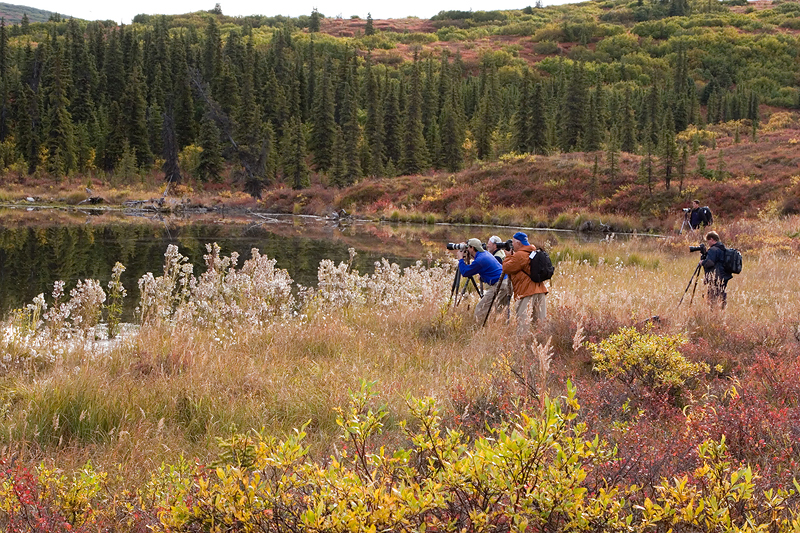 |
| Van Os Tour group photographing mastodon flowers, Denali NP, Alaska, © 2008 Lee Folino |
|
Here is a little of what I was shooting at the time. |
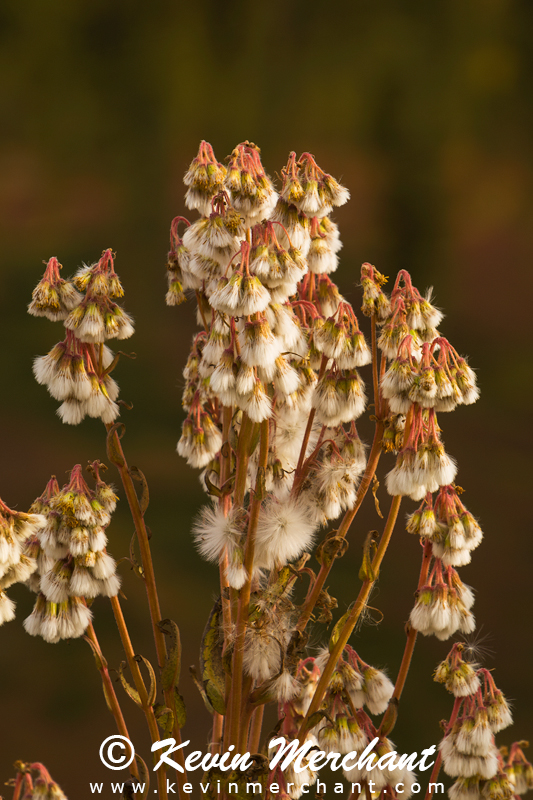 |
| Mastodon flower, Denali NP, Alaska |
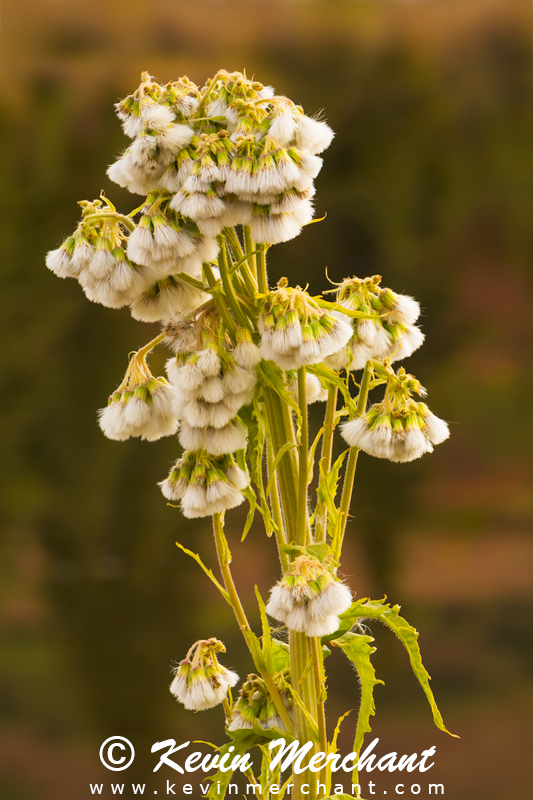 |
| Mastodon flower, Denali NP, Alaska |
|
The second is from Steve Stoltzfooss whom we met at the end of the Harding Icefield trail where I was
photographing the young black bear. The significance of this picture is how bundled up I am.
When I first started photographing the bear, I was plenty warm and didn't add any layers. After
about twenty minutes I was freezing but not anywhere near my pack. My wife came to the rescue
and brought my extra layers. I didn't really warm up until we got back to the car at 8:00 PM.
The temperature drops dramatically near sunset on the Harding Icefield, duh. |
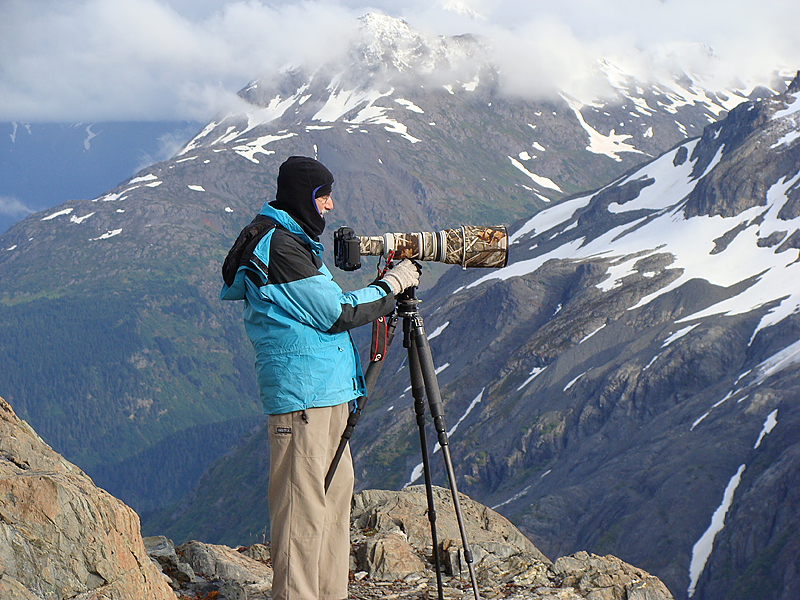 |
| Kevin with his big lens, Kenai Fjords NP, Alaska, © 2008 Steve Stoltzfooss |
|
Here is a little of what I was shooting at the time. |
 |
| Black bear, Kenai Fjords NP, Alaska |
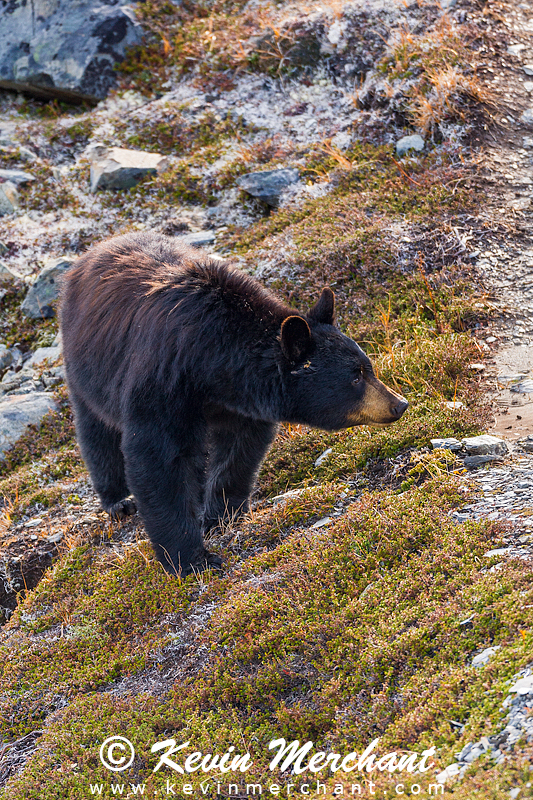 |
| Black bear, Kenai Fjords NP, Alaska |
|
You can see the rest of the images from the Alaska trip in the Gallery. |
|
September 23, 2008
Well, I'm home and didn't manage any updates on the trip. With early starts, late endings, a scramble to back up images and a dash to get a shower and/or dinner, there was little down time for doing trip updates. Needless to say, it was an amazing trip. The first week in the park had better fall color and fewer wildlife opportunities, but that's not to say there weren't wildlife opportunities, only that the ones I had the second week were better. And the fall colors peaked at different times - the reds peaking the week before I arrived and the yellows peaking on my first week in the park. Our tour group was split into two groups so that two buses could operate along the park road. We just couldn't stop in the same place at the same time. So wildlife opportunities were varied among the two groups. There were lots of landscape and macro opportunities the whole week. The only day of rain was Thursday, the day we stopped to photograph at the beaver pond near the North Face Lodge. The first two days of the photo tour Mt. McKinley was out in full view and for that we considered ourselves fortunate. Many come and never see the mountain due to clouds. On the day we were leaving the park, we got one last look at the mountain from the Stony Hill viewpoint and we all scrambled to get some shots as we hadn't seen the mountain since Tuesday. Back in Anchorage, I meet up with my wife and we're off on the next two weeks of adventure. Saturday afternoon we picked up some camping items at REI and spent the afternoon driving around Anchorage in the rain. Sunday we headed north towards the park entrance, stopping in Wasilla for (you guessed it) a Starbucks coffee and Talkeetna (the launch point for many climbers heading for Mt. McKinley). Sunday afternoon, we drove the first 15 miles of the park (the unrestricted portion for private vehicles) looking for wildlife opportunities. We saw one distant cow moose that quickly disappeared. On our way back to the entrance, we caught a glimpse of a rainbow in the afternoon light. Monday afternoon, we met up with the Camp Denali bus and headed back into Denali National Park. Mt. McKinley wasn't visible, but we had a couple of wildlife opportunities that more than made up for the lack of a view of the mountain (for me at least). After our dinner stop on the Toklat River, we came upon a large group of caribou with several bulls and a good number of cows and calves. One of the bulls had just lost the velvet on its antlers and so were still red from the blood. All of this in good afternoon light and we stopped for quite a long time. Later as we reached the kettle ponds near Wonder Lake, we came upon two bull moose at the far edge of a pond, bathed in beautiful afternoon light. Needless to say, I sort of went crazy with both of these opportunities. After the first week of busing through the park and photographing some of the wildlife from bus windows, I had a strategy down for the second trip in - sit near the front where the bus driver is positioning the bus so he can see and occupy one row of the bus so I could switch sides as needed. Also after the first week, I was really glad I had brought the bean bag as it proved invaluable photographing from the bus windows. It was a must for this trip. Arriving at Camp Denali right at sunset time, I skipped the traditional host orientation and went to work shooting the remaining light on Mt. McKinley which had appeared sometime since our last viewing opportunity. This was our last unobscured view for the week of our stay. This week's experience was different from the previous week as we didn't have a bus to take us out for the whole day dedicated to photography. Instead, we were given options each day for group activities or we could do something on our own with the only transportation being bicycles. But it didn't mean the days were less productive. Tuesday afternoon, after the group activity we spilt off from the group and photographed at the very active beaver pond, within walking distance of the camp. Wednesday we decided to take bicycles on the bus and ride back from the Eielson Visitor Center. Just before we arrived at the visitor center, we came across two grizzly cubs within very close distance of the bus and a great photo opportunity. The rest of the day was less productive (photographically speaking) with the last half of the 23 mile ride being in the rain. It was an excellent day though for riding through fall color and mountain scenery with a stop here for a common loon and a stop there for seven ptarmigan. After Wednesday, there was no more bike riding left in us - our backsides were just too sore. On Thursday, we elected to go on the Thorofare River hike which involved crossing the river to get a close look at the Muldrow Glacier. After a close encounter with the two grizzly cubs seen the day before (they didn't hang around for a photo-op) we topped a ridge only to encounter an adult grizzly and I feverishly went to work photographing this one before it disappeared. With a group of eight, the bear had no interest in us. For this hike we put our NEOS overshoes to good use crossing all of the smaller streams of the braided Thorofare River. We should have kept them on at the end for the Otter slide which we had to climb up (500 feet) to get back to the bus - muddy, muddy, muddy. The highlights for the Friday ride out included some views of Mt. McKinley and a bull moose. This was the first day of the lottery which allows 400 private vehicles per day to drive the length of the park road. A lot of other vehicles and buses had spotted this moose and stopped. At some point the moose became quite agitated and came charging down the hill directly at our bus. It was a bluff and he eventually crossed the road and disappeared out of sight down to the creek bottom. Our last wildlife sighting in the park were some dall sheep, that were slightly closer to the road than at any other time in the trip, but still not a great photo-op. We arrived back in Anchorage to the typical fall weather - rain. This weather accompanied us down to the Kenai Peninsula as we traveled to Seward. On our way, we stopped at Portage Lake to see some of the ice that comes off the glacier. It was raining - sideways. This did not bode well for us as we were planning to camp in a tent that night. We camped at the Ptarmigan Creek Campground near Moose Pass in the rain, but it was not too bad. The next day, we went in to Seward but the rain was not going to let up. Rather than wait out the weather, we decided to head towards Homer. Along the way we stopped at Tern Lake to photograph trumpeter swans. We continued on to Hidden Lake (in the Kenai National Wildlife Refuge) to camp for the night. At least we were out of the rain. The next day we stopped at a lake with several pacific loons. Continuing on to Soldotna we explored the area - in the rain. So, the next day we left for Homer where we spent the next 3 nights at the Beluga Lake Lodge. That evening while dining at Captain Pattie’s we were greeted with a beautiful sunset. The next morning we went to the end of Homer Spit for sunrise and were treated to a view of the Kenai Mountains with nice light. One of the main attractions of Homer, for photographers anyway, are the bald eagles. While it is not quite the time of year for the high concentration, there are resident eagles that are more accessible on the spit than in other places. I was determined to get at least one good opportunity. On the third night we were heading back to the hotel from dinner when I spotted one down on the beach. I had several good shooting opportunities from the vehicle with the bean bag draped over the window. The bird finally flew off and we called it a night. On our last morning in Homer I went looking for one more eagle opportunity and was not disappointed. A perfect way to end our visit. Now it was time for the drive back to Seward for the good weather. With a stop at Tern Lake for more trumpeter swan shots, we went back to the Ptarmigan Creek Campground to spend the night. The next day we got up to nice weather, went to get a Starbucks coffee, and headed into Kenai Fjords National Park to visit the Exit Glacier and the Harding Icefield. 11:30 AM is not the earliest of starts for an 8 mile round trip hike that included 3000 feet of elevation gain, but we wanted to see the Harding Icefield. So, off we went. Due to the bear density in the area, while we were below tree-line, we made a sufficient amount of noise to alert any bears that might be near the trail. One party passed us and asked if we had seen the bear - we had not. We met another party coming down and they said there was a bear on the trail about a mile away. We continued on out of the forest and were treated to excellent views of the surrounding mountains and the Exit Glacier. We reached the emergency shelter near the end of the trail and a party told us there was a young black bear just up ahead. We went on more alert until another party told us the bear was just below us. They were amazed when I pulled out my tripod and 500mm lens. I was amazed I had carried all that weight so far, but was glad I had it. The bear could care less if we were there or not as it was too busy eating. We had read about a condition that bears go into just before hibernating called hyperphasia - an increased appetite to consume calories. This bear was definitely in that state. On the way back, down below tree line we heard a noise in the brush just off the trail. Near the end of the hike another party caught up to us and asked if we had seen the adult black bear - we had not SEEN it, but we sure HEARD it. We didn't get back to the car until about 8:00 PM at which point we went to Seward in search of food. After dinner, we decided to get a hotel rather than camp because we were so tired from the hike. The Holiday Inn had no rooms - there was a music festival that weekend, after the cruise ship season ended. We did manage to get a room at the historic Hotel Seward. We were so tired that night and the next morning that we didn't really take the time to appreciate it. A repeating theme on the trip was that we would just have to come back. The next day we returned to Anchorage to fly home in the evening. But it wasn't
the end of the wildlife viewing. We stopped at Potter's Marsh, part of the
Anchorage Coastal Wildlife Refuge and we were not disappointed - there were 3
pairs of trumpeter swans, two of which were in close range. |
|
August 31, 2008
Our tour group gathered in the hotel lobby last night and headed off to dinner. A friendly group of people, some retired, some career professionals, some serious amateurs, and one other full time photographer couple. It was an early rise this morning, to be on the bus by 8:00. We headed north from Anchorage and made stops in Wasilla (a Starbucks stop, yes!), a stop in Talkeetna for lunch and photos. Mt. McKinley was out today, which we understand is unusual. By the time we arrived at the park entrance, it was shrouded in clouds, in its more typical state. We are staying at the McKinley Chalet, which is outside the park entrance, for the night. Tomorrow afternoon about 1:30 PM, we meet our transportation to the North Face Lodge near Kantishna, the end of the park road. We are hoping to make stops along the way to photograph but we are at the whims of the driver. We are all hoping the driver will be accommodating to our desires, but we will be going in with the other guests of the lodge. Tonight, we enjoyed a buffet dinner at the hotel. There was some nice light on the clouds that we could see after dinner, but there was no real opportunity for photos, being nestled amongst the surrounding peaks. |
|
August 30, 2008
The flight to Anchorage left Seattle more or less on time at 6:00 AM this morning. Just as we lifted off, the sun was peaking over the eastern horizon for a nice start to the flight. About two and a half hours into the flight, the coastal range mountains began to appear. As we were nearing Anchorage, Mt. McKinley towered above everything else in the distance. |
 |
| Coastal Range, Alaska |
 |
| Coastal Range, Alaska |
 |
| Coastal Range, Alaska |
 |
| Coastal Range, Alaska |
|
We had an uneventful landing in Anchorage, welcomed by a sunny dry day. The plane flew west of the airport over the water and then turned back to approach heading east. You had the feeling we were going to make a water landing, but just at the right moment, land appeared and all was well. A quick call to the Holiday Inn Express for the shuttle, a short wait and I was there. There is no roar of a nearby freeway because there is no nearby freeway. Instead, you have the steady sound of pontoon boats landing and taking off. It is said that there is one airplane for every six Alaskans here. When you look at a map and see how few roads there are, that is very believable. |
|
August 29, 2008
Shortly, I will be flying to Anchorage, Alaska for a three week trip. The first week will be spent in Denali National Park, travelling with a Joseph Van Os Photo Safari group for the "Denali National Park in Autumn" trip. The leaders for the trip are Len Rue Jr. and Jeff Vanuga. At the end we travel back to Anchorage where I will meet up with my wife to spend two more weeks in the area. We are going back into the park and staying at Camp Denali Lodge for several days. With the restricted travel access in the park, this is one of the better ways to enter and photograph. Once we leave the park, we will work our way back south to the Kenai Peninsula where there is a wealth of opportunities for scenery and wildlife. For trip planning purposes, one of the first purchases was the 2007 edition of Milepost, the indispensible travel guide for Alaska. This has more information than you can possibly remember, which is why we're taking it with us. With the anticipated wet and cold weather, a fair amount of our climbing clothing will come in handy for this trip. A few special things have been added to our usual collection - down sweaters for the colder temperatures and NEOS waterproof overshoes for the wet tundra hiking. We are also taking the medium weight long underwear as well as the standard light weight. New to the photo gear mix are items that have been on my list for some time - the BLUBB (Big Lens Ultimate Bean Bag) bean bag from Arthur Morris, a camouflage neoprene cover for the 500mm lens, a homemade rain cover for the same lens, Corningware F-16-PC and F-24-PC covers which serve to replace the bulky leather cover for the 500mm lens, two 250GB external hard disks for image backup, and the Delkin SensorScope for cleaning the imaging sensors on the cameras. Of course there are other miscellaneous items that have been picked up along the way. Tonight I do my final pack for the trip. About two weeks ago, we did an initial pack to see what the weight was going to be. With all of the airline challenges that have come into play in the last few years, checked bag weight is being watched closely. Since we are travelling separately, and I need all of the photo gear the first week, it's a little trickier than usual. I will have to check a second bag and I'm using an Eagle Creek duffle bag that I've used many times for both climbing and photo trips. I hope to be doing updates as the trip goes along. Internet access will be one challenge as we are planning to do some camping. We'll see how it goes. |
|
August 19, 2008
After the 4th of July weekend, I decided to go to the lavender farms on the Washington Olympic Peninsula. I had gone the previous year for a weekend visit with my wife. I wanted to spend more time there, so I allowed for an additional two days. This year was different as we have had an unusually cool summer. The color was no where near peak, and for the lavender, you really want the peak color. No problem, I thought, I'll go out to Obstruction Point in the Olympic National Park and photograph the avalanche lilies like I had done the year before. Except, the winter storms had done massive damage to the road that goes to Obstruction Point. Most of the damage was from wind fallen trees across the road, along with a large boulder here and there. I hiked about half a mile before turning back. It really was an obstructed point. I actually knew the road wasn't open, but really had no sense of how severe it
would be. So, I spent the first morning shooting black-tailed deer and after
the aborted hike, decided my time would be better spent with the deer in the
afternoon. For two days, I photographed the black-tailed deer on Hurricane
Ridge - bucks, does, and several fawns, including twins. The lupine was in full
bloom, along with American bistort, a sort of small white cotton ball on long
stems. And, there was really nice light. It was an amazing experience. To see the deer, check out MAMMALS DEER in the GALLERY. |
|
June 19, 2008
QUESTION: What do you get when you cross digital photography with birds? That's what I have learned in the last three years since switching from film to digital capture and seriously pursuing bird photography. Three years ago I bought my first digital SLR, the Canon EOS 20D. Not the top tier camera from Canon, but it produced a respectable 8 megapixel image. This camera body was my initial switch from Pentax to Canon gear. Later that year I began pursuing freelance photography full time and bought a 500mm telephoto lens for the purpose of wildlife photography. Not long after the purchase of the 20D, Canon released the EOS 5D, a 12 megapixel D-SLR body. It was about twice the price of the 20D but it has a full frame sensor which gave me back wide-angle capability for landscapes, so I took the plunge. Fast forward to early this year - I bought one of Canon's 2 new flagship D-SLR bodies, the 10.1 megapixel EOS 1D Mark III. My primary use for this body will be wildlife. It has many advantages over the 5D, not the least of which is retaining autofocus when adding a 1.4x or 2x teleconverter to the 500mm lens. All of that is an introduction to the answer given above about a huge learning curve. Switching to a digital camera might not seem like a big deal but you immediately (if not sooner) run into a lot of new terminology - RAW, white balance, histogram, crop factor, color space, color temperature, etc. A host of settings buried in a number of menus awaits, and each camera body is a little or a lot different (in the case of the 1D Mark III). Do I shoot RAW? JPEG? RAW + JPEG? Do I use Adobe RGB or sRGB color space? I could go on and on. Getting back to the bird photography part of the question, the 500mm telephoto lens definitely puts you in the range of being able to photograph these fast and always on the move little creatures. Sometimes I wish for a 600mm lens, but that will have to wait. Suddenly, you have a lens that is heavy and bulky enough to require its own special tripod head - what's known as a gimbal head which makes managing one of these lenses a lot easier. Now getting sharp photos of birds is another matter. This is where that steep learning curve comes into sharp focus. |
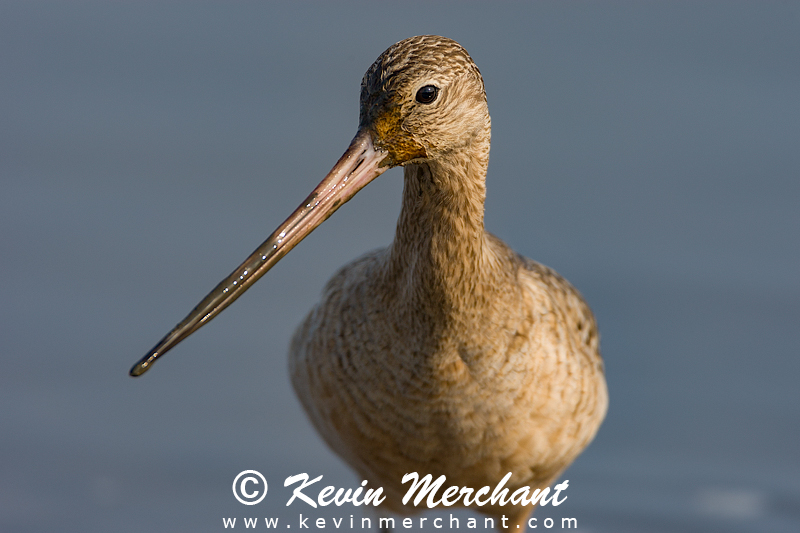 |
| Marbled Godwit, Tokeland Marina, Washington |
|
Going back to the spring of 2006, I made one of my first serious bird photo outings (my first was for bald eagles on the Skagit River, but that's another story) to Grays Harbor on the Washington coast for shore bird migration. This is an event that I had dreamed of experiencing for years but never seemed to find or make the time for. The migration occurs over a period of time only the birds can determine, but there is roughly a three week period when the largest number of birds is concentrated in each area along the Pacific coast as they are travelling north to the arctic tundra for breeding season. I arrived on the tail end (pardon the pun) of this three week period, so the number of birds on each succeeding day was diminishing. |
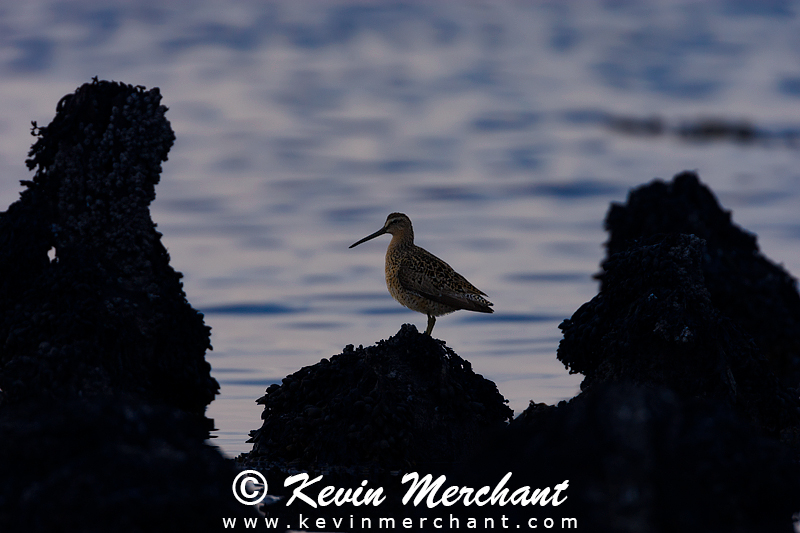 |
| Short-billed Dowitcher, Bottle Beach, Washington |
|
I've got my EOS 20D, 500mm lens with the special gimbal head, so I should be set, right? Did I mention trying to get close enough to the birds so that they were recognizable in the frame? It became evident to me that just being in the general vicinity of the birds, while good, isn't really sufficient for those frame filling sort of shots you see in magazines. The birds ebb and flow with the tides because they are feeding on the mud flats, which are exposed as the tides go out and covered as the tides come in. The best opportunities are when the tide is coming in covering the mud, which forces the birds to come in close to the shoreline and then as it is going out. And, of course, the best times of day for photographers are early morning and late afternoon. There are only a few days each month where the high tide aligns with both early morning and late afternoon. Then there are a few more days each month where you get a high tide near one or the other. Then there are days where it is simply better to plan something else to do. On my last day of this one week trip I managed to time an early morning with a high tide and came home with a few good shots out of approximately 480. |
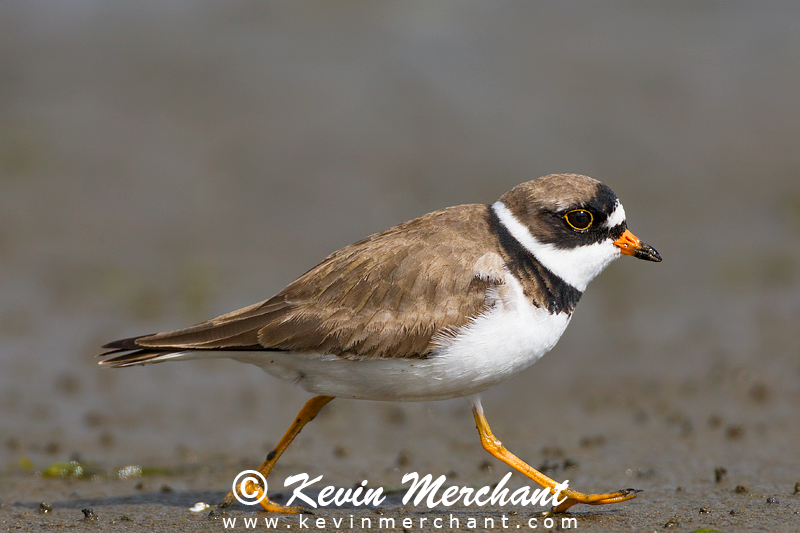 |
| Semipalmated Plover, Bottle Beach, Washington |
|
The next year I was determined to go again, this time for two weeks. Armed with better location information and more knowledge of how to use the equipment - "this time I'll come home with killer shots". And, yeah, I have the EOS 5D this time. Not quite so naive as to believe that equipment was going to make me better at this game (I've been at this too long for that) I did have high hopes about seeing improvements. And I did. The new locations yielded much better results, with approximately 2900 shots made. It doesn't hurt to get out and practice, practice, practice. |
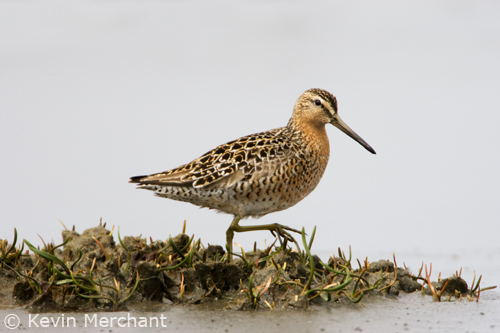 |
| Short-billed Dowitcher, Bottle Beach, Washington |
|
This year, once again, I went for a two week period with good timing for the migration. And, yeah, a newer camera body that is actually suited for this very type of photography - the Canon EOS 1D Mark III. The success rate was higher due to autofocus at longer focal lengths (you lose autofocus when adding a 2X teleconverter to the 500mm lens on the 5D) and improved technique. I came home with almost unedited 3500 images. These of course, have been edited down to about 80. That is actually not surprising, considering the fast moving subject matter. To see more, check out BIRDS SHOREBIRDS in the GALLERY. |
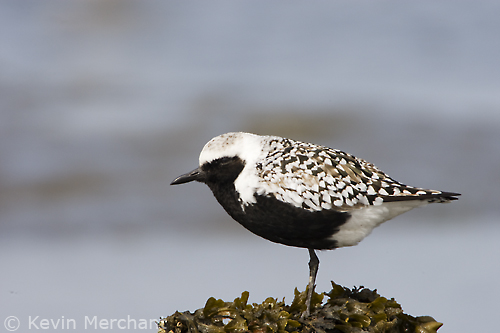 |
| Black Bellied Plover, Bottle Beach, Washington |
| © KEVIN MERCHANT PHOTOGRAPHY |
|
All photographs appearing on this site are Copyrighted
property of Kevin Merchant Photography and are protected under United States and
international copyright laws and have been registered with the U.S. Copyright Office. Contact Kevin Merchant Photography for licensing terms of all photographs appearing on this site. |